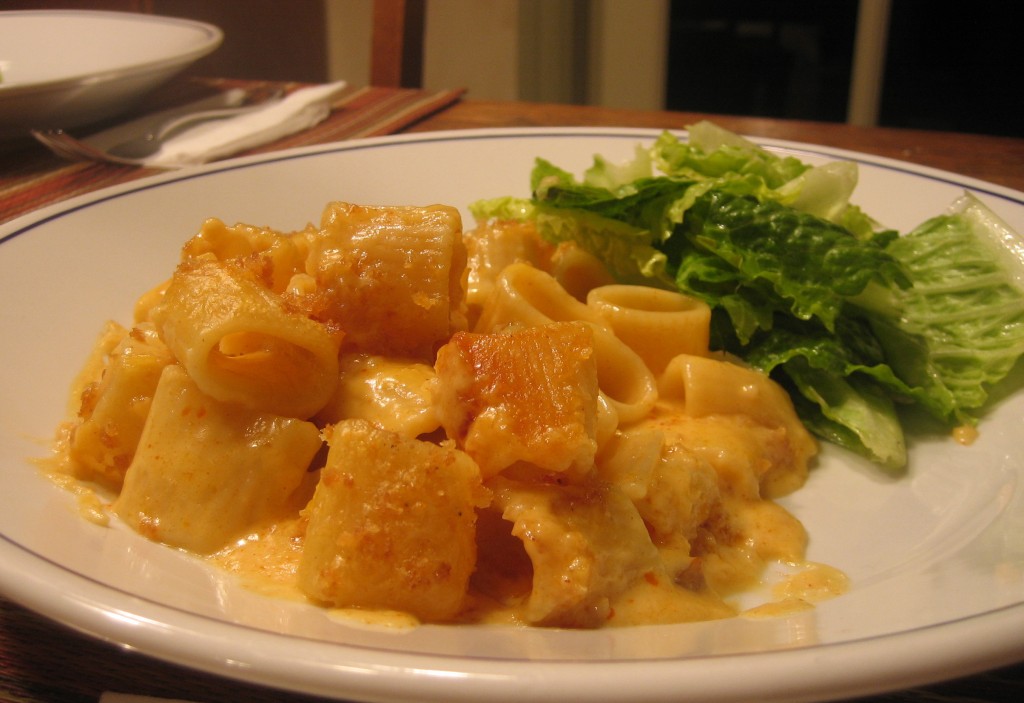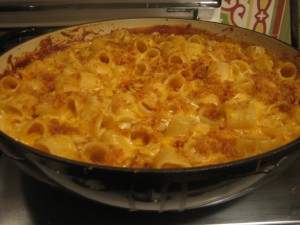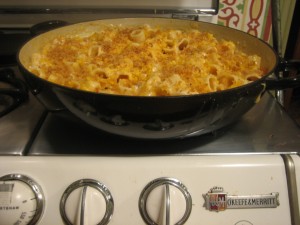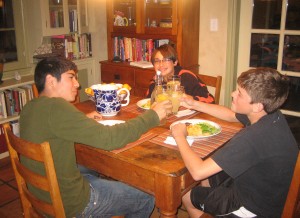Making and keeping friends can be a tough game for kids. If your child brings any issues to the table, it can be even tougher. It’s also one of the most heartbreaking moments for a parent to see his child struggle with trying to form strong friendships and fail.
Andrew was a tough kid to be with in the early days. Not only was he dealing with the death of his mother, he was also an uncontained mass of energy who could be very unnerving for adults and kids alike. Think of a super ball that has been let loose with a hard throw in a small room and you start to get the idea. I’ll never forget the pain I felt the day I saw Andrew sit at a table of fifth-grade boys wanting to make friends and seeing them all stand up and move to another table, leaving him to eat alone. It is still a memory that is hard to relive and even harder to write about. However, Andrew’s number one asset is his resiliency and he was undaunted and continued to seek ways to connect.
One of the ways I tried to help was to put him into sports, hoping that having a common goal with other boys would allow for friendships to emerge. Of course, nobody mentioned that joining the sporting world was also a big commitment on the part of the parents. It turns out that the very small print on the soccer dad/mom contract clearly states that all of your weekends for the next ten years are to be donated to the team. You start to wonder if, perhaps, there isn’t an easier way to build self-esteem.
Soccer was my first choice for Andrew, but the season was coming to a close when I became his dad and baseball would have to be our first sporting adventure. It was a disastrous foray into the world of sport parenting. It turns out that there is a difference between baseball parents and soccer parents. Just the paperwork to get on a team alone should have tipped me off that baseball parents take their role much more seriously and wanted everyone else too as well. It didn’t help that Andrew spent the entire season laying in left field – during the actual games. Needless to say, we didn’t make too many friends from that era.
Soccer was different. It allowed for Andrew’s natural tendencies to run and keep running. What he initially lacked in talent and skill he made up for in raw energy. It helped that the other boys also kept moving so there was less of a chance of dramatic and painful impact. Andrew made it through the season, but still no friends. On more than one occasion I overheard kids and moms talking about birthday parties and social gatherings with other team members, but had yet to receive an invitation for Andrew to attend. I often wondered why others couldn’t see the amazing kid I saw when I looked at Andrew.
If I have learned anything from Andrew, resiliency is at the top of the list. We continued to enroll in AYSO soccer each season, and Andrew kept improving his skills: soccer and social. A few invitations to play dates started to happen and the coaches started to talk to me about Andrew’s natural abilities on the field. However, it usually came as an apology as to why Andrew wasn’t going to be chosen for the All- Star Team. He had the talent, they would say, but was still a bit hard to coach. Perhaps next year.
Andrew finished his fifth season this year. When I got the e-mail that he had been accepted into All Stars, I was so excited that I wrapped it up and helped Santa a bit by stuffing it into Andrew’s Christmas stocking. I had been warned about the All- Star season extending into some future decade, but was happy for Andrew and what this said about his personal progress.
Meeting Andrew’s team and their families alleviated any anxiety I had about the time commitment I had just signed up for. Andrew still thinks he knows more than the coaches, but their patience and the easy camaraderie he displays with his teammates are heartwarming. Unfortunately, we just can’t seem to win a game.
This weekend, as we drove home from our second tournament in a row with zero wins, I was feeling bad for the boys and worried about morale. That’s when I received a phone call from one of the moms asking me if I knew about some plan some of the boys had hatched to come over to our house and hang out with Andrew. I hadn’t heard, but knew what this really meant: For Andrew it was a sign that he has figured out the intricate social game we all play, and for me it meant I needed to come up with an All-Star Meal that would ease the pain of four losses.
As I cooked away in the kitchen, I could hear the laughter coming from the game room and I would occasionally peak in on the boys as they attempted to kill zombies and whatever else the Xbox brought their way (yes, I gave in to that device). What I saw was a comfortable gathering of friends huddled together in intimate teenage bonding. It’s true that they had lost all of their games so far, but from my vantage point I could only see a championship win.
________________________________________________________________
Nothing says “comfort” like a big plate of homemade Mac and Cheese. If you have never made it, you are in for a treat. The real thing has absolutely nothing in common with the orange stuff that comes in a box. This is a recipe that can be thrown together when you get home from work and be on the table in about an hour. You can even make it the night before and bake it the next day. This is a very forgiving recipe and my version (based on a Los Angeles Times recipe I cut out of the paper some years ago) can change substantially from one night to another depending on what I have in the fridge. Use the basic recipe and get creative.
Portions for this are nebulous. Normal distribution would be about 10 to 12 servings. If you are serving ravenous All Star soccer players, you can safely count on 4 servings. I served it with a green salad with a Meyer lemon vinaigrette and fresh Meyer lemon lemonade.
Total time: 1 hour, 10 minutes
Servings: 10 to 12
1/2 cup breadcrumbs, preferably Panko
1 teaspoon melted butter
½ cup (1 stick) butter
½ cup flour
5 cups milk
¼ teaspoon nutmeg
½ teaspoon dry mustard
¼ teaspoon white pepper
A couple of good grindings of fresh black pepper
¼ teaspoon cayenne pepper
1 ½ teaspoons Spanish paprika (Spanish paprika has an ethereal smoky quality that adds a ton of flavor. It can be found under Pimenton de la Vera and will say “Sweet” on the label.)
2 links Spanish chorizo, about 4 oz (optional) Spanish chorizo is a cured sausage not to be confused with the fresh Mexican variety. Portuguese linguisa would make a decent substitute.
1 teaspoon salt
1 bay leaf
3 cups grated mild cheese like a mild cheddar, Jack or Spanish Manchego
3 cups grated stronger cheese like a Swiss Gruyere, French Comte, or Raclette
1 cup grated cheese from one of the above cheeses for topping casserole before you put it into the oven
Cheese note: The point with the cheese is to not worry too much about the mix. I use whatever I have in the fridge. If you are at all like me, you will have enough cheese in one configuration or another.
1 pound short pasta (penne, rigatoni, large shells, and the like work well)
½ cup heavy cream
1. Heat the oven to 350 degrees. Toss the panko bread crumbs with the melted butter on a small baking pan. Toast the bread crumbs until lightly browned, about 10 minutes. Set aside to cool.
2. In a large saucepan, heat the butter over medium heat until melted, then stir in the flour. Heat and stir until the mixture is smooth and bubbling, about 2 minutes. Remove from the heat and whisk in the milk. Add the dry mustard, white, black, and cayenne pepper, nutmeg, salt, paprika, and bay leaf. Heat and stir to boiling, then reduce the heat to a low simmer and cook 30 minutes, stirring occasionally. Remove the bay leaf.
3. While the sauce cooks, bring a large pot of salted water to a boil and cook the pasta. When done, drain and stir in a little olive oil to prevent the pasta from sticking until you are ready to use it.
4. Stir in the 6 cups of cheese until melted and add the chorizo if using. Pour the sauce over the cooked pasta in a large bowl, stirring until all of the pasta is coated. Pour the pasta into a well-buttered 9-by-13-inch casserole. Drizzle heavy cream around the edges of the casserole. Sprinkle on the remaining 1 cup cheese, then the toasted breadcrumbs.
5. Cover the casserole with aluminum foil. Bake 20 minutes. Remove the foil and bake uncovered an additional 10 minutes
Note: If you have a large casserole dish that can go from stovetop to oven like a Le Crueset, make the sauce in it and add the pasta directly to the casserole. Don’t worry about buttering the pan, it won’t stick. See photo.
Provecho!



